PEUGEOT 5008 2012 Owners Manual
Manufacturer: PEUGEOT, Model Year: 2012, Model line: 5008, Model: PEUGEOT 5008 2012Pages: 340, PDF Size: 16.42 MB
Page 201 of 340
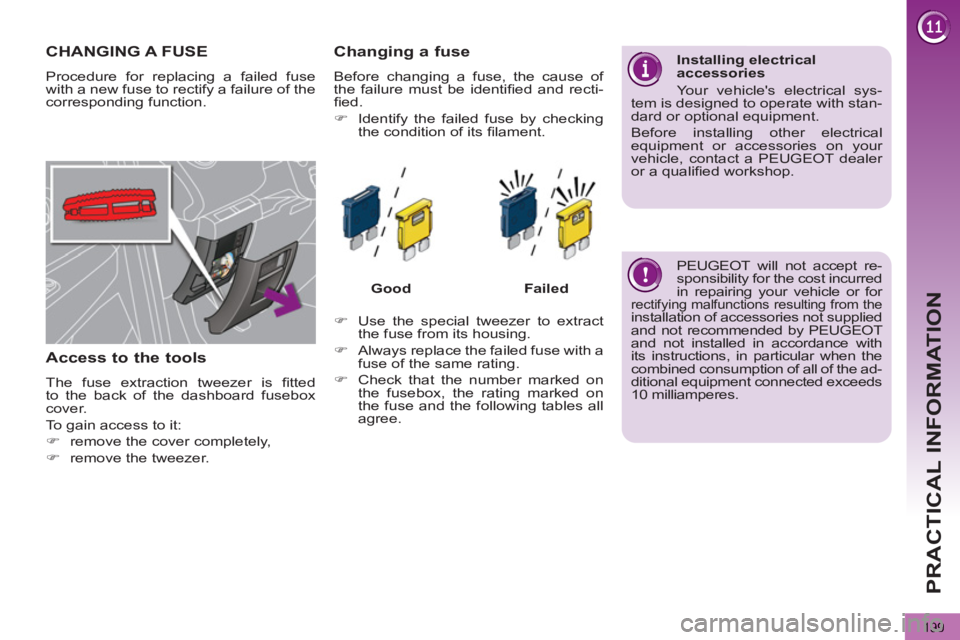
PRACTICAL INFORMATION
199
PEUGEOT will not accept re-
sponsibility for the cost incurred
in repairing your vehicle or for
rectifying malfunctions resulting from the installation of accessories not supplied
and not recommended by PEUGEOT
and not installed in accordance with
its instructions, in particular when the
combined consumption of all of the ad-
ditional equipment connected exceeds
10 milliamperes.
Installing electrical
accessories
Your vehicle's electrical sys-
tem is designed to operate with stan-
dard or optional equipment.
Before installing other electrical
equipment or accessories on your
vehicle, contact a PEUGEOT dealer
or a qualifi ed workshop.
CHANGING A FUSE
Procedure for replacing a failed fuse
with a new fuse to rectify a failure of the
corresponding function.
Access to the tools
The fuse extraction tweezer is fi tted
to the back of the dashboard fusebox
cover.
To gain access to it:
�)
remove the cover completely,
�)
remove the tweezer.
Changing a fuse
Before changing a fuse, the cause of
the failure must be identifi ed and recti-
fi ed.
�)
Identify the failed fuse by checking
the condition of its fi lament.
�)
Use the special tweezer to extract
the fuse from its housing.
�)
Always replace the failed fuse with a
fuse of the same rating.
�)
Check that the number marked on
the fusebox, the rating marked on
the fuse and the following tables all
agree.
Good
Failed
Page 202 of 340
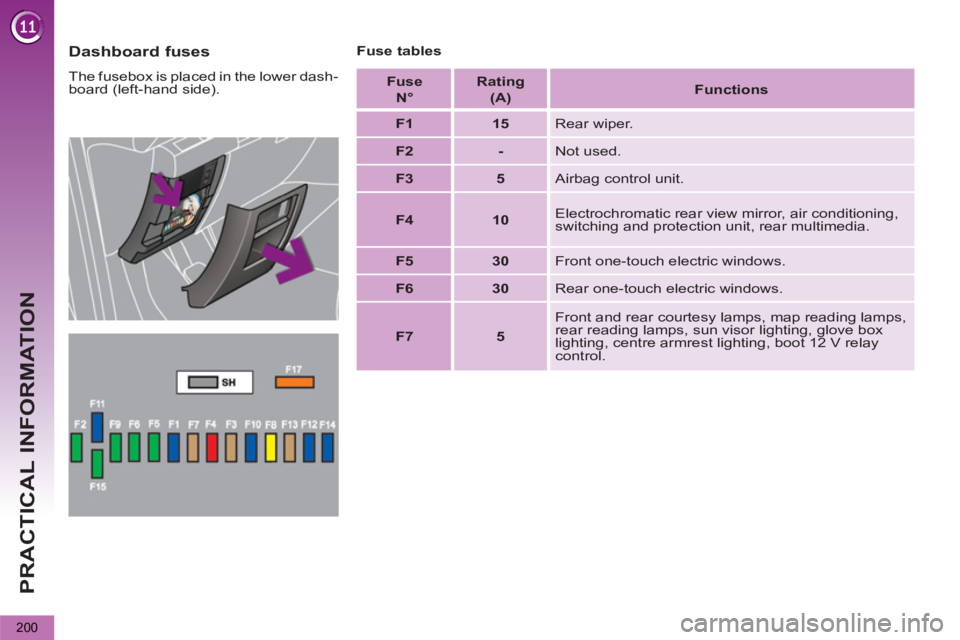
PRACTICAL INFORMATION
200
Dashboard fuses
The fusebox is placed in the lower dash-
board (left-hand side).
Fuse tables
F us e
N°
Ratin g
(A)
Functions
F1
15
Rear wiper.
F2
-
Not used.
F3
5
Airbag control unit.
F4
10
Electrochromatic rear view mirror, air conditioning,
switching and protection unit, rear multimedia.
F5
30
Front one-touch electric windows.
F6
30
Rear one-touch electric windows.
F7
5
Front and rear courtesy lamps, map reading lamps,
rear reading lamps, sun visor lighting, glove box
lighting, centre armrest lighting, boot 12 V relay
control.
Page 203 of 340
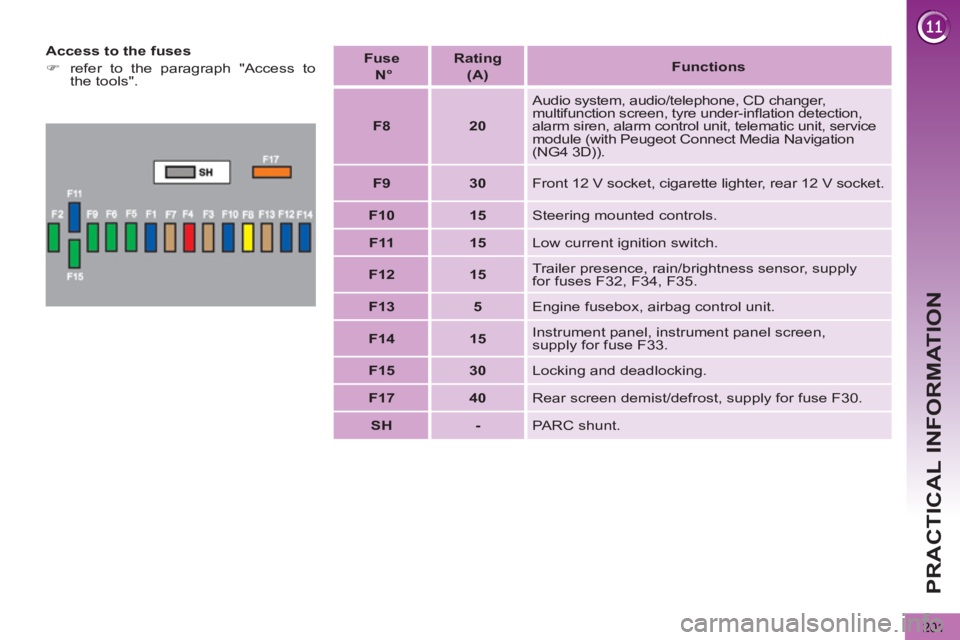
PRACTICAL INFORMATION
201
Access to the fuses
�)
refer to the paragraph "Access to
the tools".
Fuse
N°
Rating
(A)
Functions
F8
20
Audio system, audio/telephone, CD changer,
multifunction screen, tyre under-infl ation detection,
alarm siren, alarm control unit, telematic unit, service
module (with Peugeot Connect Media Navigation
(NG4 3D)).
F9
30
Front 12 V socket, cigarette lighter, rear 12 V socket.
F10
15
Steering mounted controls.
F11
15
Low current ignition switch.
F12
15
Trailer presence, rain/brightness sensor, supply
for fuses F32, F34, F35.
F13
5
Engine fusebox, airbag control unit.
F14
15
Instrument panel, instrument panel screen,
supply for fuse F33.
F15
30
Locking and deadlocking.
F17
40
Rear screen demist/defrost, supply for fuse F30.
SH
-
PARC shunt.
Page 204 of 340
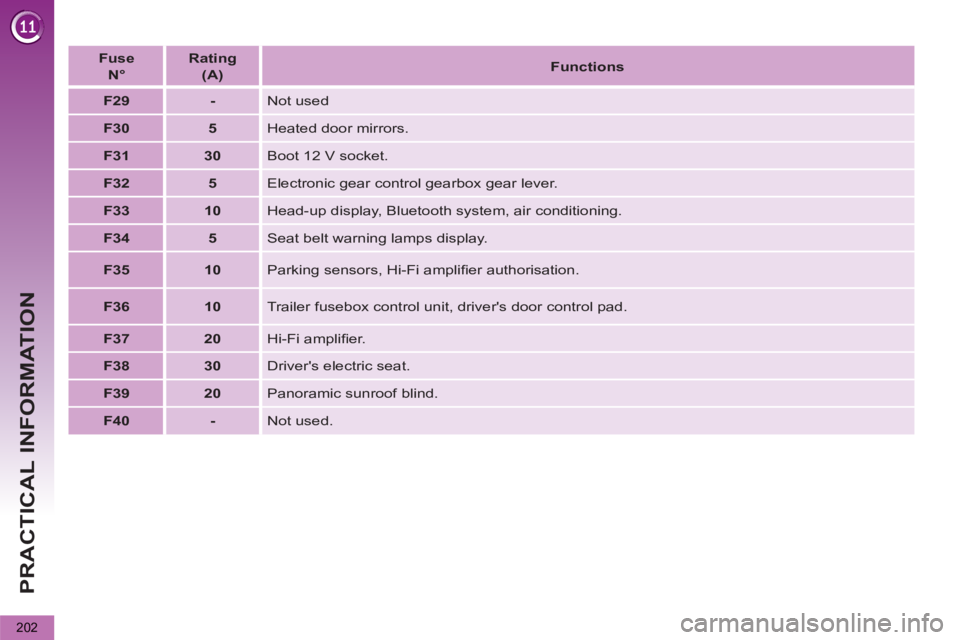
PRACTICAL INFORMATION
202
Fuse
N°
Rating
(A)
Functions
F29
-
Not used
F30
5
Heated door mirrors.
F31
30
Boot 12 V socket.
F32
5
Electronic gear control gearbox gear lever.
F33
10
Head-up display, Bluetooth system, air conditioning.
F34
5
Seat belt warning lamps display.
F35
10
Parking sensors, Hi-Fi amplifi er authorisation.
F36
10
Trailer fusebox control unit, driver's door control pad.
F37
20
Hi-Fi amplifi er.
F38
30
Driver's electric seat.
F39
20
Panoramic sunroof blind.
F40
-
Not used.
Page 205 of 340
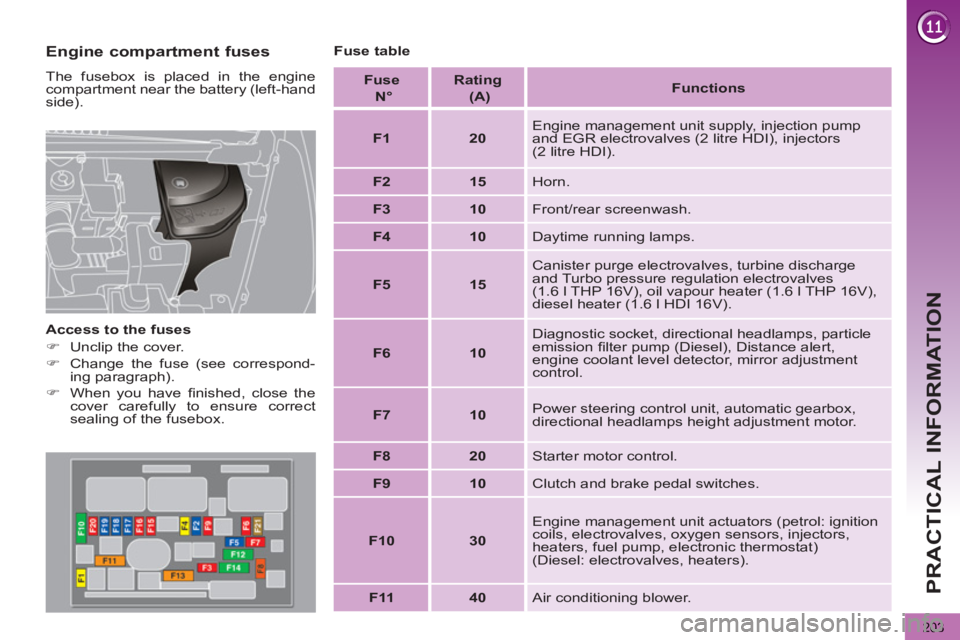
PRACTICAL INFORMATION
203
Engine compartment fuses
The fusebox is placed in the engine
compartment near the battery (left-hand
side).
Access to the fuses
�)
Unclip the cover.
�)
Change the fuse (see correspond-
ing paragraph).
�)
When you have fi nished, close the
cover carefully to ensure correct
sealing of the fusebox.
Fuse table
Fuse
N°
Rating
(A)
Functions
F1
20
Engine management unit supply, injection pump
and EGR electrovalves (2 litre HDI), injectors
(2 litre HDI).
F2
15
Horn.
F3
10
Front/rear screenwash.
F4
10
Daytime running lamps.
F5
15
Canister purge electrovalves, turbine discharge
and Turbo pressure regulation electrovalves
(1.6 l THP 16V), oil vapour heater (1.6 l THP 16V),
diesel heater (1.6 l HDI 16V).
F6
10
Diagnostic socket, directional headlamps, particle
emission fi lter pump (Diesel), Distance alert,
engine coolant level detector, mirror adjustment
control.
F7
10
Power steering control unit, automatic gearbox,
directional headlamps height adjustment motor.
F8
20
Starter motor control.
F9
10
Clutch and brake pedal switches.
F10
30
Engine management unit actuators (petrol: ignition
coils, electrovalves, oxygen sensors, injectors,
heaters, fuel pump, electronic thermostat)
(Diesel: electrovalves, heaters).
F11
40
Air conditioning blower.
Page 206 of 340
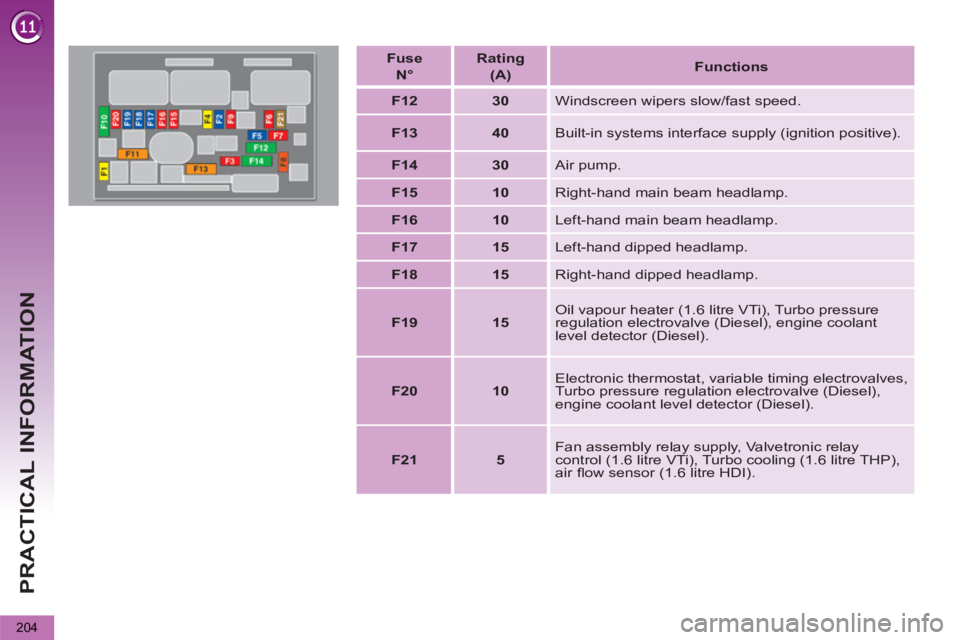
PRACTICAL INFORMATION
204
Fuse
N°
Rating
(A)
Functions
F12
30
Windscreen wipers slow/fast speed.
F13
40
Built-in systems interface supply (ignition positive).
F14
30
Air pump.
F15
10
Right-hand main beam headlamp.
F16
10
Left-hand main beam headlamp.
F17
15
Left-hand dipped headlamp.
F18
15
Right-hand dipped headlamp.
F19
15
Oil vapour heater (1.6 litre VTi), Turbo pressure
regulation electrovalve (Diesel), engine coolant
level detector (Diesel).
F20
10
Electronic thermostat, variable timing electrovalves,
Turbo pressure regulation electrovalve (Diesel),
engine coolant level detector (Diesel).
F21
5
Fan assembly relay supply, Valvetronic relay
control (1.6 litre VTi), Turbo cooling (1.6 litre THP),
air fl ow sensor (1.6 litre HDI).
Page 207 of 340

PRACTICAL INFORMATION
205
Table of mini and midi-fuses above the battery
Table of maxi-fuses
Fuse N°
Rating
(A)
Functions
F1
-
Not used.
F2
5
Dual function brake switch.
F3
5
Battery charge unit.
F4
25
ABS/ESP electrovalves.
F5
5
ABS/ESP control unit.
F6
15
Automatic gearbox, electronic gear control gearbox.
F7 *
80
Power steering electropump assembly.
F8
*
60
Fan assembly.
F9 *
80/30
Pre-heat unit (Diesel), Valvetronic electric motor
(1.6 litre THP).
F10 *
40
ABS/ESP electropump assembly.
F11 *
100
Switching and protection unit.
F12 *
30
Electronic gear control gearbox electropump
assembly.
Fuse N°
Rating (A)
Functions
MF1 *
-
Not used.
MF2 *
30
Trailer fuse box.
MF3 *
50
Passenger compartment fusebox.
MF4 *
80
Built-in systems interface.
MF5 *
80
Built-in systems interface.
MF6 *
30
Electric parking brake.
MF7 *
30
Heated front seats.
MF8 *
20
Headlamp wash.
*
The maxi-fuses and certain other fuses
provide additional protection for the elec-
trical systems. All work on the these fus-
es must be carried out by a PEUGEOT
dealer or a qualifi ed workshop.
Page 208 of 340
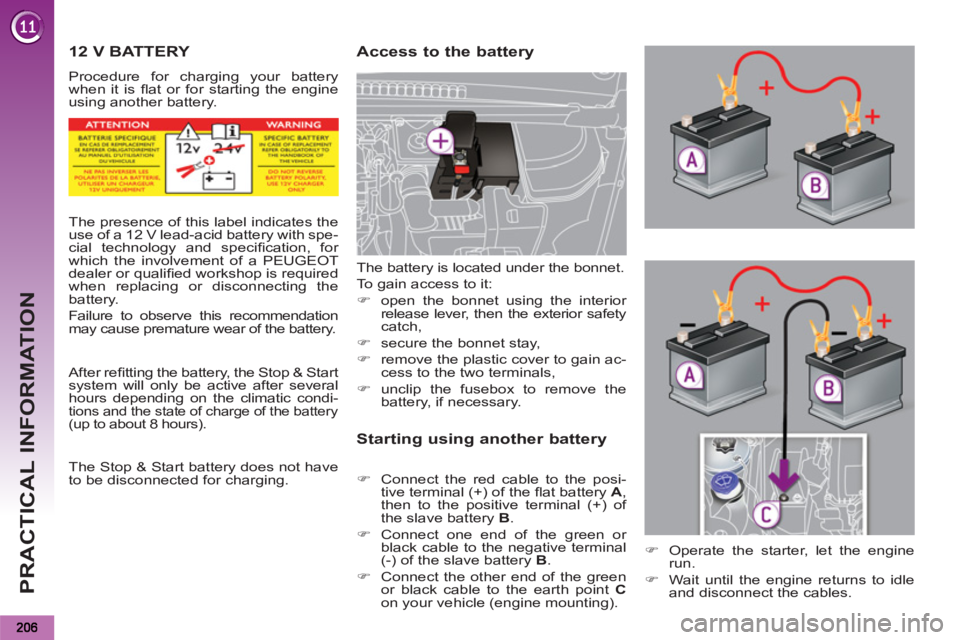
PRACTICAL INFORMATION
12 V BATTERY
Procedure for charging your battery
when it is fl at or for starting the engine
using another battery.
Access to the battery
Starting using another battery
�)
Connect the red cable to the posi-
tive terminal (+) of the fl at battery A
,
then to the positive terminal (+) of
the slave battery B
.
�)
Connect one end of the green or
black cable to the negative terminal
(-) of the slave battery B
.
�)
Connect the other end of the green
or black cable to the earth point C
on your vehicle (engine mounting). The battery is located under the bonnet.
To gain access to it:
�)
open the bonnet using the interior
release lever, then the exterior safety
catch,
�)
secure the bonnet stay,
�)
remove the plastic cover to gain ac-
cess to the two terminals,
�)
unclip the fusebox to remove the
battery, if necessary.
The presence of this label indicates the
use of a 12 V lead-acid battery with spe-
cial technology and specifi cation, for
which the involvement of a PEUGEOT
dealer or qualifi ed workshop is required
when replacing or disconnecting the
battery.
Failure to observe this recommendation
may cause premature wear of the battery.
After refi tting the battery, the Stop & Start
system will only be active after several
hours depending on the climatic condi-
tions and the state of charge of the battery (up to about 8 hours).
The Stop & Start battery does not have
to be disconnected for charging.
�)
Operate the starter, let the engine
run.
�)
Wait until the engine returns to idle
and disconnect the cables.
Page 209 of 340
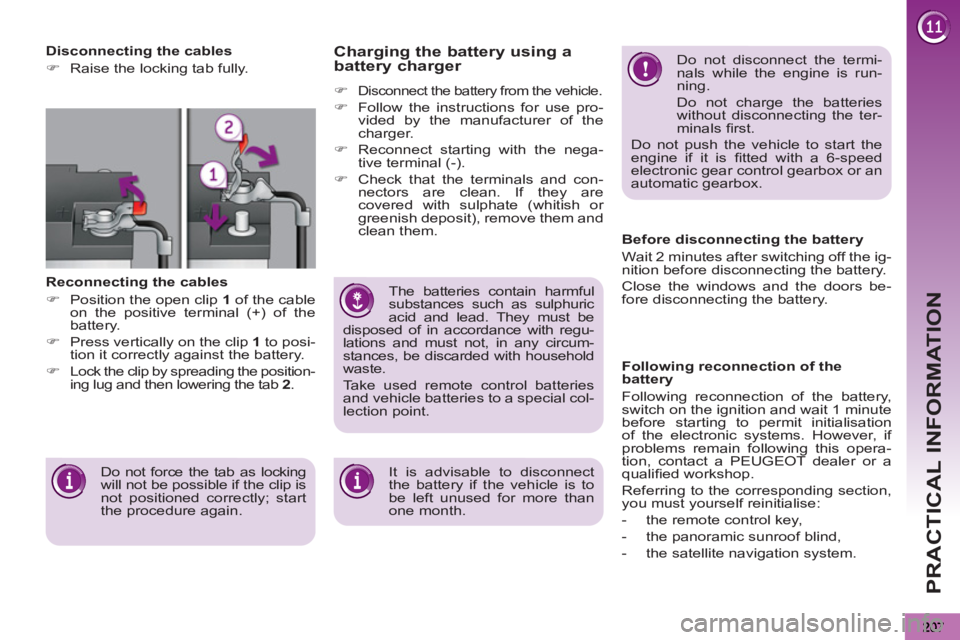
PRACTICAL INFORMATION
Do not disconnect the termi-
nals while the engine is run-
ning.
Do not charge the batteries
without disconnecting the ter-
minals fi rst.
Do not push the vehicle to start the
engine if it is fi tted with a 6-speed
electronic gear control gearbox or an
automatic gearbox.
The batteries contain harmful
substances such as sulphuric
acid and lead. They must be
disposed of in accordance with regu-
lations and must not, in any circum-
stances, be discarded with household
waste.
Take used remote control batteries
and vehicle batteries to a special col-
lection point.
Charging the battery using a
battery charger
�)
Disconnect the battery from the vehicle.
�)
Follow the instructions for use pro-
vided by the manufacturer of the
charger.
�)
Reconnect starting with the nega-
tive terminal (-).
�)
Check that the terminals and con-
nectors are clean. If they are
covered with sulphate (whitish or
greenish deposit), remove them and
clean them.
It is advisable to disconnect
the battery if the vehicle is to
be left unused for more than
one month.
Before disconnecting the battery
Wait 2 minutes after switching off the ig-
nition before disconnecting the battery.
Close the windows and the doors be-
fore disconnecting the battery.
Following reconnection of the
battery
Following reconnection of the battery,
switch on the ignition and wait 1 minute
before starting to permit initialisation
of the electronic systems. However, if
problems remain following this opera-
tion, contact a PEUGEOT dealer or a
qualifi ed workshop.
Referring to the corresponding section,
you must yourself reinitialise:
- the remote control key,
- the panoramic sunroof blind,
- the satellite navigation system.
Disconnecting the cables
�)
Raise the locking tab fully.
Reconnecting the cables
�)
Position the open clip 1
of the cable
on the positive terminal (+) of the
battery.
�)
Press vertically on the clip 1
to posi-
tion it correctly against the battery.
�)
Lock the clip by spreading the position-
ing lug and then lowering the tab 2
.
Do not force the tab as locking
will not be possible if the clip is
not positioned correctly; start
the procedure again.
Page 210 of 340
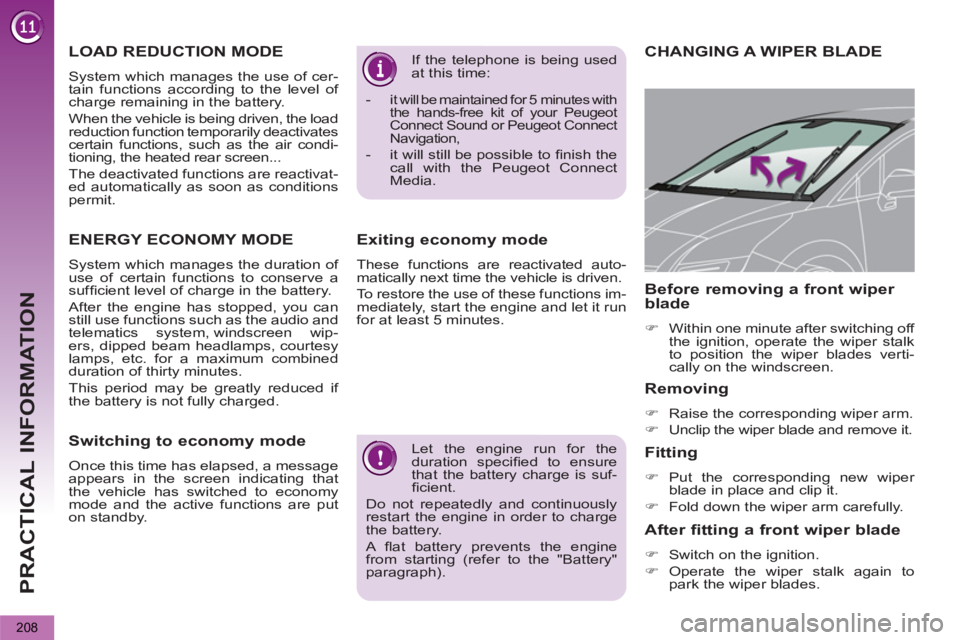
PRACTICAL INFORMATION
208
Let the engine run for the
duration specifi ed to ensure
that the battery charge is suf-
fi cient.
Do not repeatedly and continuously
restart the engine in order to charge
the battery.
A fl at battery prevents the engine
from starting (refer to the "Battery"
paragraph). If the telephone is being used
at this time:
- i
t will be maintained for 5 minutes with
the hands-free kit of your Peugeot
Connect Sound or Peugeot Connect
Navigation,
- it will still be possible to fi nish the
call with the Peugeot Connect
Media.
Exiting economy mode
These functions are reactivated auto-
matically next time the vehicle is driven.
To restore the use of these functions im-
mediately, start the engine and let it run
for at least 5 minutes.
CHANGING A WIPER BLADE
Removing
�)
Raise the corresponding wiper arm.
�)
Unclip the wiper blade and remove it.
Fitting
�)
Put the corresponding new wiper
blade in place and clip it.
�)
Fold down the wiper arm carefully.
Before removing a front wiper
blade
�)
Within one minute after switching off
the ignition, operate the wiper stalk
to position the wiper blades verti-
cally on the windscreen.
After fitting a front wiper blade
�)
Switch on the ignition.
�)
Operate the wiper stalk again to
park the wiper blades.
LOAD REDUCTION MODE
System which manages the use of cer-
tain functions according to the level of
charge remaining in the battery.
When the vehicle is being driven, the load
reduction function temporarily deactivates
certain functions, such as the air condi-
tioning, the heated rear screen...
The deactivated functions are reactivat-
ed automatically as soon as conditions
permit.
ENERGY ECONOMY MODE
System which manages the duration of
use of certain functions to conserve a
suffi cient level of charge in the battery.
After the engine has stopped, you can
still use functions such as the audio and
telematics system, windscreen wip-
ers, dipped beam headlamps, courtesy
lamps, etc. for a maximum combined
duration of thirty minutes.
This period may be greatly reduced if
the battery is not fully charged.
Switching to economy mode
Once this time has elapsed, a message
appears in the screen indicating that
the vehicle has switched to economy
mode and the active functions are put
on standby.